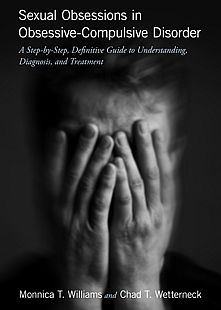OCD
Assessment and Treatment of Sexual Orientation Themed OCD
Treating sexual orientation symptoms in OCD can be tricky.
Posted March 6, 2012
Assessment of Sexual Orientation OCD
Many fear seeking help.
Many who seek treatment for sexual orientation obsessions in obsessive-compulsive disorder (SO-OCD) are unaware that they are suffering from a form of OCD. Sufferers are usually feeling distress, confusion, and shame. Inside, they know their own sexual orientation, but can't figure out why the doubts won't go away. Many are afraid of getting professional help because they worry the therapist will tell them they are gay.
People with SO-OCD may initially tell their clinician a long narrative about how they are not gay and have always been attracted to the opposite sex, before revealing their sexual-orientation worries. I find that it is typical for clients to continually ask me for reassurance before, during, and after the interview. It is also common for a client to have sought multiple opinions. In other cases, the person may not have shared their concerns with anyone due to shame or catastrophic fears that may be out of proportion with reality (e.g., "If anyone knew I had these thoughts, my life would be over and I would lose my job and family.")
In most cases, the distress experienced by the person is not related to any actual events that have happened, but is attached to the worry that the client will lose access to the opposite sex, something that is highly valued. The person fears that the sexual life they have enjoyed, or may someday enjoy, will be suddenly taken and replaced with something unappealing and foreign.
Clearly, not everyone with sexual orientation related anxiety has OCD. For example, I once assessed a middle-aged man who thought he might have SO-OCD because of ongoing doubts about whether he should leave his wife and move to Miami to start a new life as an openly gay man. He felt distress about leaving his wife, but the idea of meeting someone new of the same sex filled him with excitement. In his case, OCD was not diagnosed because the main cause of his anxiety stemmed from the possibility of hurting his wife, which was a reasonably expected outcome, rather than doubts about his sexual orientation.
Behavioral Treatment for Sexual Orientation OCD
A thorough assessment is important, as mental health professionals who do not typically treat OCD may fail to properly diagnose a client complaining of unwanted sexual orientation obsessions. It is not uncommon for therapists to attribute the symptoms to an unconscious wish, emerging homosexuality, or difficulties with sexual identity formation. This conceptualization of the problem may cause panic an already distressed individual, resulting in the client becoming even more upset and confused. The key issue to understand is that the thoughts are ego-dystonic or ego-alien, meaning that the obsessions are inconsistent with the individual's fundamental desires and sexual history. Digging for a presumed root of the problem will be of limited use.
Like other forms of OCD, SO-OCD cannot be effectively treated through reassurance or reasoning alone. Professionals may explain to the client that homosexuality is common and not something to be feared. However, typically the person with SO-OCD does not want to be gay, and normalizing homosexuality will not help the person feel more at ease. However, initial education about sexual identity and normalizing some homosexual thoughts in heterosexuals can be useful at the start. Most people have random sexual thoughts at times, including homosexual ones.
Psychological treatment should not focus on the meaning of the symptoms, as the person already spends too much time pondering this. A specialized form of psychotherapy called exposure and ritual prevention (EX/RP) is considered effective for all types of OCD. The only published treatment study focused specifically SO-OCD was a case study of one of my clients, where exposure and ritual prevention worked very well (Williams, Crozier, & Powers, 2011). The treatment included the use of customized audio recordings and same-sex imagery to trigger obsessional thoughts along with the teaching of ritual prevention strategies. In addition, the client was encouraged to confront real life situations that elicited unwanted thoughts, without doing rituals.
Although SO-OCD can be upsetting to sufferers and puzzling to clinicians, treatment works, although it may take longer than treatment for other OCD symptoms. Clients should look for providers with lots of experience treating people with OCD, and therapists should not hesitate to use EX/RP with this group of sufferers.
Also See Part I: Sexual Orientation Obsessions in OCD
Learn more about sexually-themed OCD at the OCD Types website.

New Release!
Williams, M. T. & Wetterneck, C. T. (2019). Obsessive-Compulsive Disorder: A Step-By-Step Definitive Guide for Understanding, Diagnosis, and Treatment. Oxford University Press. ISBN: 9780190624798.
References
Williams, M. (2008). Homosexuality Anxiety: A Misunderstood Form of OCD. In L. V. Sebeki (ed), Leading-Edge Health Education Issues, Nova Publishers.
Williams, M. T., Crozier, M., Powers, M. B. (2011). Treatment of Sexual Orientation Obsessions in Obsessive-Compulsive Disorder using Exposure and Ritual Prevention. Clinical Case Studies, 10, 53-66.
Williams, M. T., Davis, D. M., Tellawi, G., & Slimowicz, J. (2015). Assessment and treatment of sexual orientation obsessions in obsessive-compulsive disorder. The Australian Clinical Psychologist, 1 (1), 12-18.


